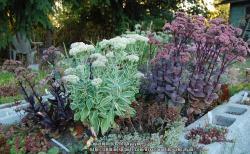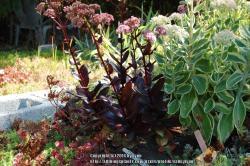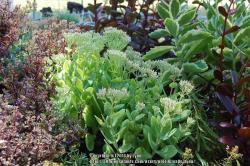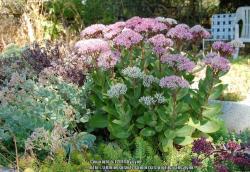| [ Hen and Chicks (Sempervivum 'Plastic') | Posted on October 16, 2014 ] 'Plastic' has proved to be a strong-growing sempervivum that stays healthy year round, in drought and in months of heavy rain.
I also found out that the bloom's size is a bit larger than many semp blooms, and the petals of the bloom are rather thick and tough feeling, almost like plastic. |
| [ Hen and Chicks (Sempervivum 'Rubikon') | Posted on October 14, 2014 ] There seems to be some confusion between S. 'Rubikon' and S. 'Rubikon Improved'.
The written description for S. 'Rubikon' is: apple green - dark red rosettes, ciliate, tips reddish, flat slower growth, sensitive to winter wet.
I'm not sure we have this cultivar correct. |
| [ Job's Beard (Sempervivum heuffelii 'Hot Lips') | Posted on October 7, 2014 ] S. heuffelii 'Hot Lips' has blooms that are very open, making hand pollinating easier. |
[ Hen and Chicks (Sempervivum 'Jungle Fires') | Posted on September 30, 2014 ]JungleShadows said: 'Jungle Shadows' was rather unique when it was born and I still find it a very pleasing semp. Visitors to my garden have really enjoyed it. It is also proving to be a very interesting parent as well. I raised a large crop from both hand crosses and bee set seed when I was in MA and 'Jungle Fires' came out of the bee seed.
The list published on the Slovenian site is mostly right although they have credited Shirley Rempel with 'Jungle Fires'. She did introduce it for me but it is definitely my hybrid. |
[ Hen and Chicks (Sempervivum 'Malby's Hybrid No. 2') | Posted on September 30, 2014 ]JungleShadows said: There were two reds that were circulated from Malby. The one that was Latinized to his name I knew was a misuse of this and Sanford did the same with one of his. What I used back then was also called "Malby's #2", which you say has been renamed 'Gloriosum'. It was one of the few that retained its color a bit longer. I don't remember it being a bicolor, more of a solid red, at least in spring in MA. All of the seedlings in the cross to 'Olivette' were bi-colors, most with the wider, flatter form. 'Stuffed Olive' was the only one with the more "olive-formed" rosette, so it got the nod as an introduction.
Kevin Vaughn |
| [ Ice Plant (Delosperma ashtonii 'Blut') | Posted on September 22, 2014 ] This delosperma was found by nurseryman Kelly Grummons (owner of Timberland Gardens, Arvada, CO) growing as a volunteer in his gravel driveway.
It is said that the bloom color is intensified by growing it "hot and dry."
There is no patent on this plant, but plants grown from seed may not come true to the parent plant. |
| [ Stonecrop (Hylotelephium telephium subsp. telephium 'Coral Reef') | Posted on September 18, 2014 ] This is an introduction from Future Plants in the Netherlands. They have a number of new plants that should be coming out soon. This is one of them.
http://www.futureplants.com/in... |
[ Hen & Chicks (Sempervivum 'Atroviolaceum Pubescent') | Posted on September 15, 2014 ]JungleShadows said:Lynn,
I know this was discussed several pages ago but I can tell you that 'Atroviolaceum' was NOT hybridized by Mina Colvin. This was one that was found way back in Correvon's or Sanford's collection. The Heimlich form was from Heimlich's Nursery in Woburn, MA, probably some time in the early 60's. Mina's first two introductions were 'Raspberry Ice' and 'Silver Thaw'.
It is unfortunate that there were so many things with the 'Atroviolaceum' tag. It would have been better to call the Heimlich plant just 'Heimlich'. The two look quite different.
All of these should be pure tectorums so the one with pubescence sounds like a hybrid with montanum, not a pure tectorum.
OK my two cents!
Kevin |
[ Hen and Chicks (Sempervivum tectorum 'Atroviolaceum') | Posted on September 15, 2014 ]JungleShadows said:Lynn,
I know this was discussed several pages ago but I can tell you that 'Atroviolaceum' was NOT hybridized by Mina Colvin. This was one that was found way back in Correvon's or Sanford's collection. The Heimlich form was from Heimlich's Nursery in Woburn, MA, probably some time in the early 60's. Mina's first two introductions were 'Raspberry Ice' and 'Silver Thaw'.
It is unfortunate that there were so many things with the 'Atroviolaceum' tag. It would have been better to call the Heimlich plant just 'Heimlich'. The two look quite different.
All of these should be pure tectorums so the one with pubescence sounds like a hybrid with montanum, not a pure tectorum.
OK my two cents!
Kevin |
[ Hen and Chicks (Sempervivum 'Atroviolaceum Heimlich 2') | Posted on September 15, 2014 ]JungleShadows said:Lynn,
I know this was discussed several pages ago but I can tell you that 'Atroviolaceum' was NOT hybridized by Mina Colvin. This was one that was found way back in Correvon's or Sanford's collection. The Heimlich form was from Heimlich's Nursery in Woburn, MA, probably some time in the early 60's. Mina's first two introductions were 'Raspberry Ice' and 'Silver Thaw'.
It is unfortunate that there were so many things with the 'Atroviolaceum' tag. It would ha e been better to call the Heimlich plant just 'Heimlich'. The two look quite different.
All of these should be pure tectorums so the one with pubescence sounds like a hybrid with montanum, not a pure tectorum.
OK my two cents!
Kevin |
| [ Hen and Chicks (Sempervivum 'Oddity') | Posted on September 11, 2014 ] Oddity would make a great addition to a miniature garden, by using a single rosette as maybe a shrub? Let your imagination decide how you might use it in your miniature garden. |
| [ Hen and Chicks (Sempervivum 'Beautiful') | Posted on September 10, 2014 ] Clone 1: light green leaves with brown tips, beautiful lashes
Erwin Geiger
Clone 1: An American culture from the 70s and yet hardly known: fresh green rosettes with strong dark brown tips which form a compact tuff. The leaf margins have strikingly white cilia. For some time, a plant called "White eyelash" has surfaced that seems very identical to the plant.
Volkmar Schara
Clone 2: makes large pink to red rosettes, showing striking colors, especially in summer. A unique plant that I have in the collection for a long time.
There are no photos or other reference made to this second version on Beautiful.
Lynn Smith
The above description for clone 1 is a perfect match for this wonderful sempervivum. Every part of the description is present in this sempervivum, from the fresh green color, dark brown tips, and the very noticeable white cilia/lashes lining the leaves. An easy one to fit in almost anywhere because of its smaller size of 2 to 3 inches diameter for a mature rosette.
|
| [ Hen and Chicks (Sempervivum Nightwood) | Posted on September 9, 2014 ]
Description of S. 'Nightwood' as given in The Sempervivum Society Journal Volume 7 (1976), No. 2:
"Growing to quite a size this hybrid has a tight central bud of incurved leaves, the tips of which are reflexed and have a minute tuft of hairs. Colour is greyed purple."
|
| [ Stonecrop (Hylotelephium SunSparkler® Blue Pearl) | Posted on September 6, 2014 ] Sedum SunSparkler® 'Blue Pearl' is the tallest Sedum or Hylotelephium I have. It topped out at 23 inches, including the flower heads, this year. It adds quite a presence in the beds with its height and color. 'Blue Pearl' has a somewhat branching habit and makes a nice full display, with strong upright stems that do not need support. It is later to bloom for me, and is just now showing open flowers.
When it first emerges from dormancy the leaves are a smoky blue/green color with blue/purple edges. As the season progresses, the leaves go through some wonderful color changes, never losing that great blue cast that overlies the other colors. It has interesting cup-shaped, almost round, leaves.
 |
| [ Stonecrop (Hylotelephium spectabile 'Elsie's Gold') | Posted on September 6, 2014 ] This H. spectabile was discovered and introduced by Lyndale Nurseries in Auckland, NZ. USPP#20368
I would not want to be without 'Elsie's Gold' in my raised beds. It is a strong growing, non-branching, but dense clumped variety that is a beautiful contrast to the darker leafed H. spectabile. In the spring the leaves emerge, showing a creamy gold color contrasting with green centers. The gold ages to cream as the growing season progresses. All stages are lovely. The bud stage has a frosty effect on the bed. It is later-blooming for me. The buds are just now starting to open (9/6/2014).
The stems are strong and need no support to keep them upright. It has been said that this is the most stable of the various variegated sports of Autumn Joy. I have had this plant for 2 years and have found no sign of reversion.
In my garden it has grown to 19 inches tall, to the top of the flower heads.
Here it is growing between 'Chocolate Drop' on the left and 'Blue Pearl' on the right.

|
| [ Sedum (Hylotelephium Candy™ Chocolate Drop) | Posted on September 6, 2014 ] 'Chocolate Drop' has the darkest leaves of all the dark-leafed sedums I have. The leaves are a very dark chocolate brown color with a hint of purple. The leaf color holds up through the growing season. It also has shiny leaves that seem to reflect light in the beds. It makes a great accent grown beside lighter-leafed plants like 'Elsie's Gold.' It is a non-branching plant that is not very dense in growth habit, but still lovely and worth growing.
'Chocolate Drop' at maturity is 18 inches to the top of the flower heads. Strong stems that stay upright without support.
Here it is growing beside 'Elsie's Gold'.
 |
| [ Sedum (Hylotelephium spectabile 'Hot Stuff') | Posted on September 6, 2014 ] H. spectabile 'Hot Stuff' is the shortest of the H. spectabile cultivars available on the market. Bred by Gary Gossett and introduced by Terra Nova Nurseries.
For me, I find this one a must-have in the succulent beds. I find that it has strong upright stems that do not flop or fall over from the center of the clump. Non-branching habit. Very different leaf color from the other sedums in the beds, nice almost pale-blue/green color.
I do not fertilize, so in my garden this plant grows to 10 inches tall to the top of the bloom heads.
Here it is growing with taller 'Plum Perfection' on the left, 'Chocolate Drop' on the right, and 'Blue Pearl' and 'Elsie's Gold' in back.
 |
| [ Stonecrop (Hylotelephium Party Hardy™ Beach Party) | Posted on September 6, 2014 ] 'Beach Party' is a nice addition to my sedum beds, adding a different level of height amongst all the other sedums. I don't fertilize my raised beds, so this sedum tops out at 16 inches to the top of the blooms.
The stems of the plant are non-branching, strong, and need no support to maintain a lovely clump. It starts blooming at the end of August in the Pacific Northwest, and it has a long bloom season, providing food for many kinds of bees. The blooms give off a lovely soft sweet scent when warmed by the sun.
I leave the seed heads until spring, when the plant first starts coming out of dormancy. The smaller birds eat the seeds over the winter.
H. 'Beach Party' with H. sieboldii on the left.
 |
| [ Hen and Chicks (Sempervivum 'Carmen') | Posted on September 3, 2014 ] S. 'Carmen' leaves are long and moderately wide. In hot weather the rosettes have faint to moderate watermarks that are lovely against its summer green color. It is a heavy producer of offsets and has good uniformity of form to the rosettes.
I find that it handles both heavy winter/spring rain, and hot summer drought season in my Pacific Northwest raised beds.
It is green year round, but does change the shade of green depending on the season. From fall to early summer it has lovely reddish/brown accents to the tips and sides of the leaves that make a pretty contrast to the green leaves. |
| [ Hen and Chicks (Sempervivum 'Aaron') | Posted on September 2, 2014 ] This is a newly arrived (summer of 2012) sempervivum from Europe. As you can see from the photos above, it has unusual color, and something of a water lily form. The leaves are covered in very short cilia, giving a velvet texture to the leaves, which are also a bit thicker than those of the average sempervivum. It seems to be slow to produce, and it produces only a few offsets in a growing season.
It seems to tolerate the Pacific Northwest's heavy winter/spring rain season.
|